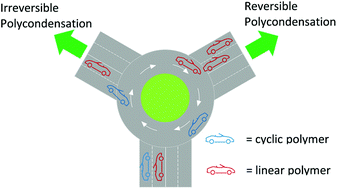Importance of a reversible reaction for the synthesis of telechelic polymers by means of polycondensation using an excess of one monomer†
Abstract
We show that reversible polycondensation through an alkoxide-catalyzed ester–ester exchange reaction is an effective strategy for the synthesis of telechelic polymers free from contamination with cyclic polymers in the polycondensation of difunctional nucleophilic monomers and difunctional electrophilic monomers (A2 + B2 polycondensation). Polycondensation of excess diol formate 1 and 1.0 equiv. of dimethyl dicarboxylate 2 at high monomer concentrations afforded polyesters with a hydroxyl group at both ends, uncontaminated with cyclic polymers. On the other hand, the polycondensation of 1.0 equiv. of 1 and excess 2 selectively afforded polymers with a methyl ester moiety at both ends, even at lower monomer concentrations. Under the same conditions, the irreversible polycondensation of a diol and diacid chloride invariably afforded cyclic polymers, as well as telechelic polymers end-capped with the excess monomer. These results indicated that cyclic polymers, formed during reversible polycondensation, are converted into telechelic polymers by an ester–ester exchange reaction of the cyclic polymers with the excess monomer. Furthermore, the polycondensation of equimolar 1 and 2 in the presence of a symmetrical ester molecule having two functional groups as an exchange reagent (ExR) afforded a variety of telechelic polyesters with the functional groups derived from the ExR at both ends. Notably, when bis[poly(ethylene glycol) (PEG)] isophthalate was used as the ExR, a PEG-b-polyester-b-PEG triblock copolymer was obtained.



 Please wait while we load your content...
Please wait while we load your content...